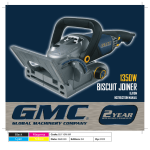Download DeWalt DW682K Technical data
Transcript
® DW682K 4 3 2 6 11 1 5 8 7 A 10 9 2 9 4 6 1 B C1 11 8 C2 D 6 7 F E 12 G H 10 J K1 14 K2 13 5 5 15 L 5 cm 5-7. #0 5 cm 15-2 #10 #20 M N1 N2 N3 P N4 5-7.5 cm 15-25 cm 15-25 cm Q1 Q2 R1 R2 R3 S1 S2 T U1 U2 U3 U4 V1 V2 V3 V5 V4 ENGLISH BISCUIT JOINTER DW682K Congratulations! You have chosen a DEWALT Power Tool. Years of experience, thorough product development and innovation make DEWALT one of the most reliable partners for professional Power Tool users. Take appropriate measures for the protection of hearing if the sound pressure of 85 dB(A) is exceeded. Weighted root mean square acceleration value according to EN 50144: Table of contents DW682K Technical data EC-Declaration of conformity Safety instructions Package contents Description Electrical safety Mains plug replacement (U.K. & Ireland only) Using an extension cable Assembly and adjustment Instructions for use Maintenance Guarantee Voltage (U.K. & Ireland only) Power input No load speed Depth of cut, max. Plunge depth adjustment Cutter diameter Cutter width Weight Fuses: Europe U.K. & Ireland V V W min-1 mm mm mm mm kg 230 V tools 230 V tools en - 1 en - 1 en - 1 en - 2 en - 2 en - 2 en - 2 en - 3 en - 3 en - 4 en - 5 en - 5 DW682K 230 230/115 600 10,000 22 8/10/12 (for biscuits 0/10/20) 100 4 3 10 Amperes, mains 13 Amperes, in plugs The following symbols are used throughout this manual: Denotes risk of personal injury, loss of life or damage to the tool in case of non-observance of the instructions in this manual. Denotes risk of electric shock. EC-Declaration of conformity DW682K DEWALT declares that these Power Tools have been designed in compliance with: 89/392/EEC, 89/336/EEC, 73/23/EEC, EN 50144, EN 55104 / EN 55014-2, EN 55014, EN 61000-3-2 & EN 61000-3-3. For more information, please contact DEWALT at the address below, or refer to the back of themanual. Level of sound pressure according to 86/188/EEC & 89/392/EEC, measured according to EN 50144: DW682K LpA (sound pressure) LWA (acoustic power) * at the operator’s ear 11 dB(A)* 90.9 dB(A) 104 < 2.5 m/s2 Director Engineering and Product Development Horst Großmann DEWALT, Richard-Klinger-Straße 40, D-65510, Idstein, Germany Safety instructions When using Power Tools, always observe the safety regulations applicable in your country to reduce the risk of fire, electric shock and personal injury. Read the following safety instructions before attempting to operate this product. Keep these instructions in a safe place! General 1 Keep work area clean Cluttered areas and benches can cause accidents. 2 Consider work area environment Do not expose Power Tools to humidity. Keep work area well lit. Do not use Power Tools in the presence of flammable liquids or gases. 3 Guard against electric shock Prevent body contact with earthed surfaces (e.g. pipes, radiators, cookers and refrigerators). For use under extreme conditions (e.g. high humidity, when metal swarf is being produced, etc.) electric safety can be improved by inserting an isolating transformer or a (FI) earth-leakage circuit-breaker. 4 Keep children away Do not let children come into contact with the tool or extension cord. Supervision is required for those under 16 years of age. 5 Extension cords for outdoor use When the tool is used outdoors, always use extension cords intended for outdoor use and marked accordingly. 6 Store idle tools When not in use, Power Tools must be stored in a dry place and locked up securely, out of reach of children. 7 Dress properly Do not wear loose clothing or jewellery. They can be caught in moving parts. Preferably wear rubber gloves and non-slip footwear when working outdoors. Wear protective hair covering to keep long hair out of the way. 8 Wear safety goggles Also use a face or dust mask in case the operations produce dust or flying particles. 9 Beware of maximum sound pressure Take appropriate measures for the protection of hearing if the sound pressure of 85 dB(A) is exceeded. 10 Secure workpiece Use clamps or a vice to hold the workpiece. It is safer and it frees both hands to operate the tool. en - 1 ENGLISH 11 Do not overreach Keep proper footing and balance at all times. 12 Avoid unintentional starting Do not carry the plugged-in tool with a finger on the switch. Be sure that the switch is released when plugging in. 13 Stay alert Watch what you are doing. Use common sense. Do not operate the tool when you are tired. 14 Disconnect tool Shut off power and wait for the tool to come to a complete standstill before leaving it unattended. Unplug the tool when not in use, before servicing or changing accessories. 15 Remove adjusting keys and wrenches Always check that adjusting keys and wrenches are removed from the tool before operating the tool. 16 Use appropriate tool The intended use is described in this instruction manual. Do not force small tools or attachments to do the job of a heavy-duty tool. The tool will do the job better and safer at the rate for which it was intended. Warning! The use of any accessory or attachment or performance of any operation with this tool, other than those recommended in this instruction manual may present a risk of personal injury. 17 Do not abuse cord Never carry the tool by its cord or pull it to disconnect from the socket. Keep the cord away from heat, oil and sharp edges. 18 Maintain tools with care Keep the tools in good condition and clean for better and safer performance. Follow the instructions for maintenance and changing accessories. Inspect the tool cords at regular intervals and, if damaged, have them repaired by an authorized DEWALT repair agent. Inspect the extension cords periodically and replace them if damaged. Keep all controls dry, clean and free from oil and grease. 19 Check for damaged parts Before using the tool, carefully check it for damage to ensure that it will operate properly and perform its intended function. Check for misalignment and seizure of moving parts, breakage of parts and any other conditions that may affect its operation. Have damaged guards or other defective parts repaired or replaced as instructed. Do not use the tool if the switch is defective. Have the switch replaced by an authorized DEWALT repair agent. 20 Have your tool repaired by an authorized DEWALT repair agent This Power Tool is in accordance with the relevant safety regulations. To avoid danger, electric appliances must only be repaired by qualified technicians. Additional safety rules for biscuit jointers Plugging into the mains, switching ON and OFF • Always ensure that the power tool is switched OFF before plugging into the mains. • Do not switch OFF before the blade is running freely. When cutting • Remove all nails and metal objects from the workpiece before starting work. • After switching OFF, never attempt to stop the blade by pressing against the side of the blade. • Never put the tool down on a table or workbench unless switched OFF. Operational protection devices • The tool must only be used for cutting wood or plastic. • Ensure that all devices screening the blade are in perfect working order. en - 2 Checking and changing the blade • Only blades conforming to the specifications contained in these operating instructions may be used. • Blades made of high alloy, high speed steel (HSS steel) should not be used. Best results are achieved using carbide-tipped or CrV blades. • Only sharp blades in perfect working order should be used; cracked or bent blades should be discarded and replaced at once. • Ensure that the blade is securely fixed and rotates in the correct direction. Guard against kickback • Kickback occurs when the tool begins to stall rapidly and is driven back towards the operator. Release the switch immediately if the blade sticks or the tool stalls. • Keep the blades sharp. • Support large panels near the cutting area. • Do not remove the tool from the workpiece while making a cut with the blade rotating. Release the ON/OFF-switch and wait for the blade to come to a halt. Package contents The package contains: 1 Biscuit jointer 1 Dust bag 2 Dust adapters 1 Pin spanner 1 Torx screwdriver 1 Instruction manual 1 Exploded drawing • Check for damage to the tool, parts or accessories which may have occurred during transport. • Take the time to thoroughly read and understand this manual prior to operation. Description (fig. A) Your DEWALT biscuit jointer DW682K has been designed for making flat dowel joints in wood and wood products. 1 ON/OFF-switch 2 Lock-on button 3 Top handle 4 Fence height adjuster 5 Dust extraction outlet 6 Adjustable fence 7 Anti-slipping pins 8 Plunge depth adjusting knob 9 Locking knob 10 Spindle lock 11 Star knob Electrical safety The electric motor has been designed for one voltage only. Always check that the power supply corresponds to the voltage on the rating plate. Your DEWALT tool is double insulated in accordance with EN 50144; therefore no earth wire is required. Mains plug replacement (U.K. & Ireland only) • Should your mains plug need replacing and you are competent to do this, proceed as instructed below. If you are in doubt, contact an authorized DEWALT repair agent or a qualified electrician. • Disconnect the plug from the supply. • Cut off the plug and dispose of it safely; a plug with bared copper conductors is dangerous if engaged in a live socket outlet. • Only fit 13 Amperes BS1363A approved plugs fitted with the correctly rated fuse (1). 12 ENGLISH • The cable wire colours, or a letter, will be marked at the connection points of most good quality plugs. Attach the wires to their respective points in the plug (see below). Brown is for Live (L) (2) and Blue is for Neutral (N) (4). • Before replacing the top cover of the mains plug ensure that the cable restraint (3) is holding the outer sheath of the cable firmly and that the two leads are correctly fixed at the terminal screws. Never use a light socket. Never connect the live (L) or neutral (N) wires to the earth pin marked E or . For 115 V units with a power rating exceeding 1500 W, we recommend to fit a plug to BS4343 standard. Using an extension cable If an extension cable is required, use an approved extension cable suitable for the power input of this tool (see technical data). The minimum conductor size is 1.5 mm2. When using a cable reel, always unwind the cable completely. Also refer to the table below. Conductor size (mm2) 0.75 1.00 1.50 2.50 4.00 Voltage 115 230 Amperes 0 - 2.0 2.1 - 3.4 3.5 - 5.0 5.1 - 7.0 7.1 - 12.0 12.1 - 20.0 0 - 2.0 2.1 - 3.4 3.5 - 5.0 5.1 - 7.0 7.1 - 12.0 12.1 - 20.0 Cable rating (Amperes) 6 10 15 20 25 Cable length (m) 7.5 15 25 30 Cable rating (Amperes) 6 6 6 6 6 6 6 6 6 6 10 15 10 10 15 20 15 15 20 25 20 20 25 6 6 6 6 6 6 6 6 6 6 6 6 10 10 10 10 15 15 15 15 20 20 20 20 45 60 6 15 20 20 25 6 6 10 15 20 25 10 15 20 25 6 6 15 15 20 - Assembly and adjustment To set the fence angle: • Slacken the star knob (11). • Tilt the fence into the required angle. • Tighten the star knob. Jointer base markings When working without the fence, for example when making T-joints, you can use the markings on the jointer base for proper alignment of the tool. • Set the fence to the 0° position as described above. • For workpieces with a thickness of 19 mm, use the edge of the base as a reference for centring. • For other workpieces, use the red centreline markings to align the tool. • Two of the markings indicate the length of the cut. In order to prevent breaking through the workpiece, make sure that the workpiece extends beyond these markings. Plunge depth adjustment (fig. D) The plunge depth must be set to match the biscuit size. The numbers 0, 10 and 20 on the depth adjusting knob correspond with the biscuit size. The M represents the maximum cutting depth of approx. 22 mm. • Turn the depth adjusting knob (8) into the required position, aligning the appropriate number with the red marking on the tool. Plunge depth fine adjustment (fig. E) The fine adjustment is used to eliminate possible tolerances in the size of the biscuit slots. • Raise the fence (6) to its upper position as described above. • Insert the Torx screwdriver as shown and adjust the plunge depth as required by turning the screw (turn clockwise to decrease the plunge depth). • Check the setting by making a trial cut in a piece of scrap wood. Anti-slipping pins (fig. F) The anti-slipping pins (7) help to reduce the tendency of the biscuit jointer to slide to the right when cutting. When working on visible parts of the workpiece, you may want to retract them in order to avoid scratching. • To retract the pins, rotate them slightly clockwise using a flat screwdriver. • To use the pins again, rotate them slightly counterclockwise. Replacing the blade (fig. G, H & J) • Remove the four Torx screws (12) from the base plate and take off the cover. • Depress the spindle lock (10) and remove the flange by turning it counterclockwise. • Change the blade. • Tighten the flange securely by turning it clockwise while keeping the spindle lock depressed. • Mount the cover plate and tighten the Torx screws. • Make sure that the teeth of the cutter point in counterclockwise direction as shown (fig. H). • After replacing the blade, always check the cutting depth and adjust if necessary. Prior to assembly and adjustment always unplug the tool. Adjustable fence (fig. C1 & C2) The adjustable fence (6) allows you to precisely set the point where the slots for the biscuits are cut. To set the fence height: • Slacken the locking knob (9). • Set the height adjuster (4) as required. With the fence set to 90°, the scale under the locking knob reads the distance between the centre of cutter and the surface of the fence. • Tighten the locking knob. 13 Dust extraction (fig. K1 & K2) Using the appropriate adapter, you can connect either a dustbag or a dust extractor. Dust extractor • Insert the appropriate adapter (13) or (14) into the dust extraction outlet (5). • Connect the dust extractor hose to the adapter. en - 3 ENGLISH Dustbag • Insert the straight adapter (13) into the dust extraction outlet (5). • Attach the dustbag (15) to the adapter. • Whenever possible, connect a dust extraction device designed in accordance with the relevant regulations regarding dust emission. Instructions for use Always observe the safety instructions and applicable regulations. Switching ON and OFF (fig. B) • To run the tool, press the ON/OFF-switch (1). • If necessary, press the lock-on button (2) for continuous operation and release the switch. • To stop the tool, release the switch. • To stop the tool in continuous operation, press the switch briefly and release it. Always switch OFF the tool when work is finished and before unplugging. Do not switch the tool ON or OFF when the blade touches the workpiece or other materials. Making biscuit joints General (fig. L) Various techniques can be used to make strong and accurate biscuit joints. In this manual, the most important techniques will be discussed in more detail. Selecting the biscuit size (fig. M) The three biscuit sizes are #0, #10 and #20. Normally, you should use the largest biscuit that will fit in the workpiece. • After selecting the size of biscuit to be used, adjust the plunge depth accordingly as described above. Always make a trial cut in a piece of scrap wood to check the plunge depth. If necessary, perform a fine adjustment as described above. Locating the biscuits (fig. N1 - N4) • For edge joints, biscuits should normally be located at 15 - 25 cm intervals.The outer biscuits should be located 5 - 7.5 cm from the ends of the workpiece (fig. N1). • When joining narrow workpieces such as picture frames, even the smallest biscuits may be too large for the joint. In this case, the exposed tip of the biscuit should be trimmed off after the joint has been glued (fig. N2). • When joining workpieces thicker than approx. 2.5 cm, pairs of biscuits may be used for additional strength (fig. N3). • To mark mating pieces, first position them as they will be assembled. Use a set square to draw the marking line across the pieces (fig. N4). Cutting biscuit slots (fig. P) • Adjust the tool settings as described above. • Align the centre marking on the tool base with the marking line as shown. • Switch the tool on and wait a second for the cutter attain full speed. • Firmly push the fence against the workpiece and plunge the cutter until the stop is reached. • Allow the tool to retract the blade from the workpiece. • Turn the tool off. en - 4 Assembling the workpieces • Try assembling the workpieces together to check that the joints fit correctly. • Evenly spread a suitable glue in the biscuit slots and on the mating surfaces of the joint. • Insert the biscuits into the slots, ensuring that they come into contact with the glue. • Assemble the workpieces and clamp them until the glue has dried. Edge to edge joints (fig. Q1 & Q2) • Place the workpieces on a flat surface as they are to be assembled. • Mark the biscuit centres. The biscuits should be located at 15 - 25 cm intervals; the outer biscuits should be located 5 - 7.5 cm from the ends of the workpiece (fig. Q1). • Set the fence to 90°. • Set the height adjuster to position the biscuit in the centre of the workpiece. • Adjust the other tool settings as described above. • Cut the biscuit slots as described above (fig. Q2). Frame joints (fig. R1 - R3) • Place the workpieces on a flat surface as they are to be assembled (fig. R1 & R2). • Select the appropriate biscuit size. • Mark the biscuit centres. • Adjust the tool settings as described above. • Cut the biscuit slots as described above (fig. R3). Corner joints (fig. S1 & S2) • Arrange the workpieces as they are to be assembled (fig. S1). • Select the appropriate biscuit size. • Mark the biscuit centres. • For the face cut, clamp the workpiece and align the tool as shown (fig. S2). • Cut the biscuit slots as described above. Offset joints (fig. T) When joining two workpieces of different thickness, proceed as follows: • Arrange the workpieces as they are to be assembled. • Select the appropriate biscuit size. • Mark the biscuit centres. • Select the workpiece that will be set back. • Set the height adjuster to position the biscuit in the centre of the workpiece. • Cut the biscuit slots as described above. • Adjust the fence up by a distance equal to the desired offset. Use the scale to read the setting. • Cut the biscuit slots as described above. Edge mitre joints (fig. U1 - U4) Outside surfaces aligned (fig. U1) • Arrange the workpieces as they are to be assembled. • Mark the biscuit centres on the outside of the joint. • Set the fence angle to 90°. • Adjust the fence to locate the biscuit toward the inside of the joint where the workpiece is thicker. Select the appropriate biscuit size (fig. U2). • Clamp the workpiece and align the tool as shown (fig. U3). • Cut the biscuit slots as described above. Inside surfaces aligned • Arrange the workpieces as they are to be assembled. • Mark the biscuit centres on the inside of the joint. • Set the fence angle to 45°. • Adjust the fence to locate the biscuit toward the inside of the joint where the workpiece is thicker. Select the appropriate biscuit size. 14 ENGLISH • Clamp the workpiece and align the tool as shown (fig. U4). • Cut the biscuit slots as described above. T-joints (fig. V1 - V5) This type of joints is commonly used to attach shelves to side panels (fig. V1). • Place the workpieces on a flat surface as they are to be assembled (as an upside down T). • Mark the biscuit centres on the shelf piece. • Lightly mark the top of the shelf on the side panel (fig. V2). • Clamp the fence on top of the side panel, aligning the end of the shelf with the line (fig. V3). • Select the appropriate biscuit size. • Set the fence to 0°. • Align the tool with the biscuit marks using the markings on the tool base. • Make a vertical (fig. V4) and a horizontal (fig. V5) cut at each of the biscuit locations. Consult your dealer for further information on the appropriate accessories. Maintenance Your DEWALT Power Tool has been designed to operate over a long period of time with a minimum of maintenance. Continuous satisfactory operation depends upon proper tool care and regular cleaning. Lubrication Your Power Tool requires no additional lubrication. GUARANTEE • 30 DAY NO RISK SATISFACTION GUARANTEE • If you are not completely satisfied with the performance of your DEWALT tool, simply return it within 30 days, complete as purchased, to the point of purchase, for a full refund or exchange. Proof of purchase must be produced. • ONE YEAR FREE SERVICE CONTRACT • If you need maintenance or service for your DEWALT tool, in the 12 months following purchase, it will be undertaken free of charge at an authorized DEWALT repair agent. Proof of purchase must be produced. Includes labour and spare parts for Power Tools. Excludes accessories. • ONE YEAR FULL WARRANTY • If your DEWALT product becomes defective due to faulty materials or workmanship within 12 months from the date of purchase, we guarantee to replace all defective parts free of charge or, at our discretion, replace the unit free of charge provided that: • The product has not been misused. • Repairs have not been attempted by unauthorized persons. • Proof of purchase date is produced. This guarantee is offered as an extra benefit and is additional to consumers statutory rights. For the location of your nearest authorized DEWALT repair agent, please use the appropriate telephone number on the back of this manual. Cleaning Keep the ventilation slots clear and regularly clean the housing with a soft cloth. Unwanted tools and the environment Take your tool to an authorized DEWALT repair agent where it will be disposed of in an environmentally safe way. 15 en - 5























